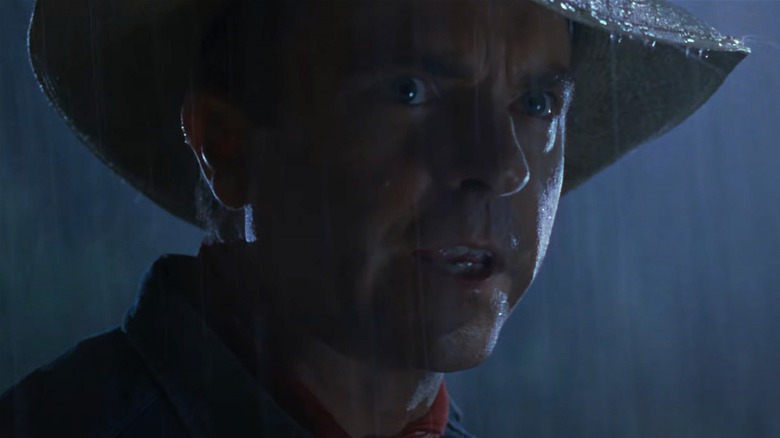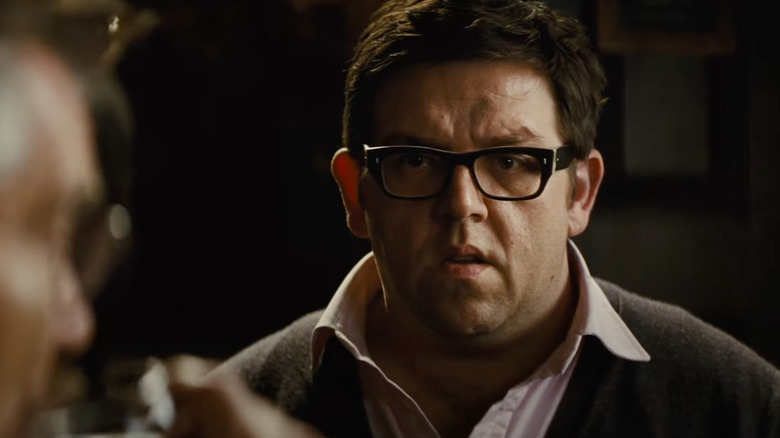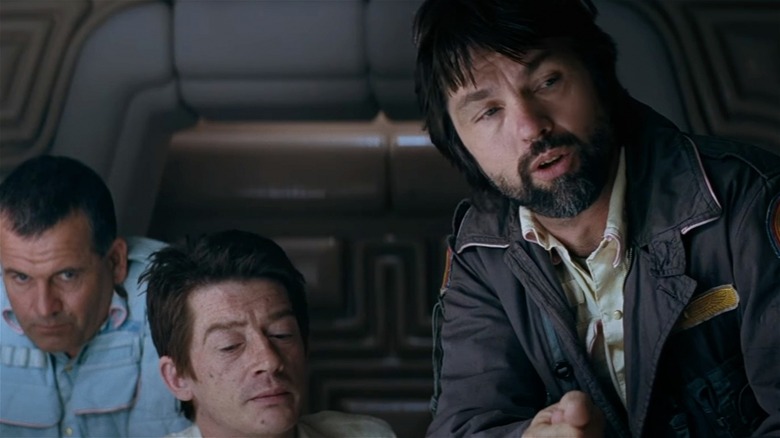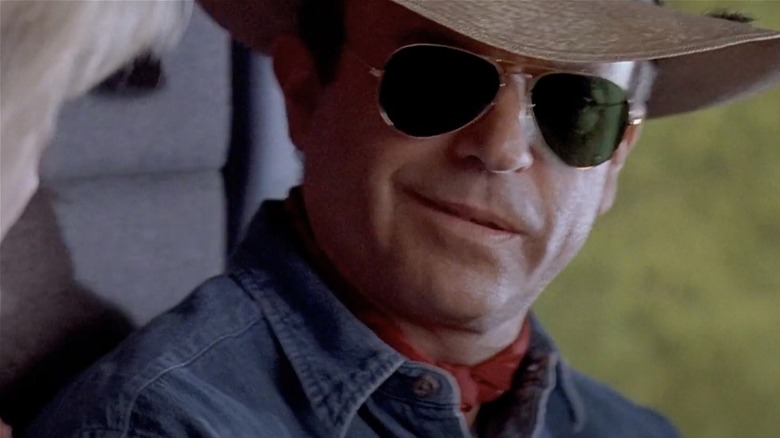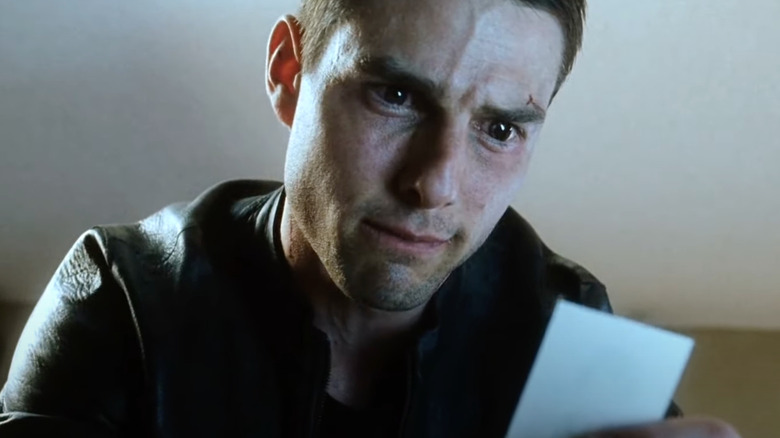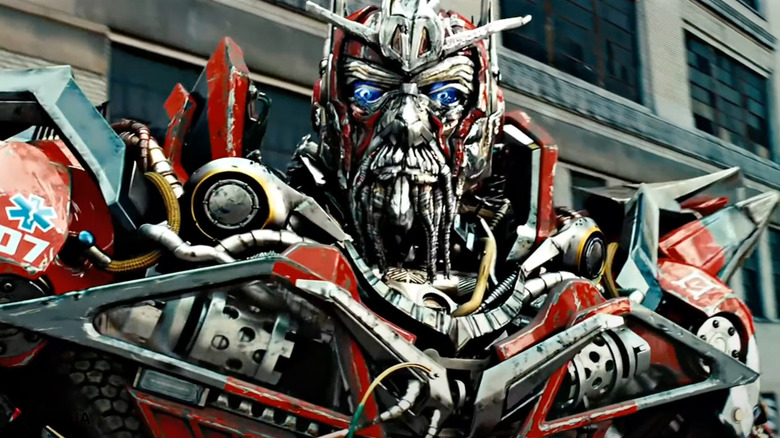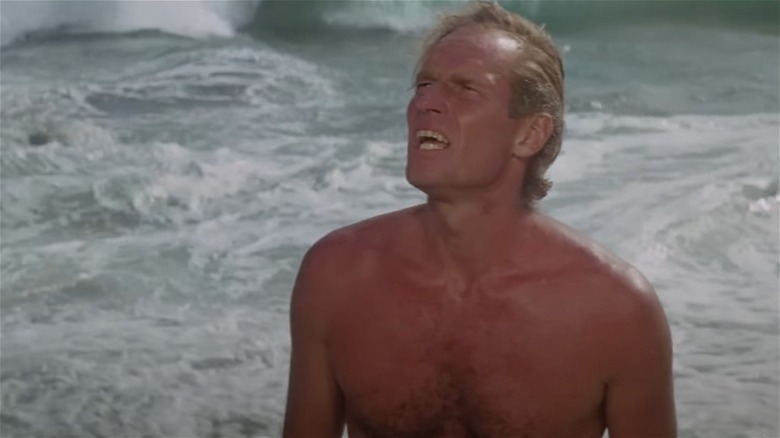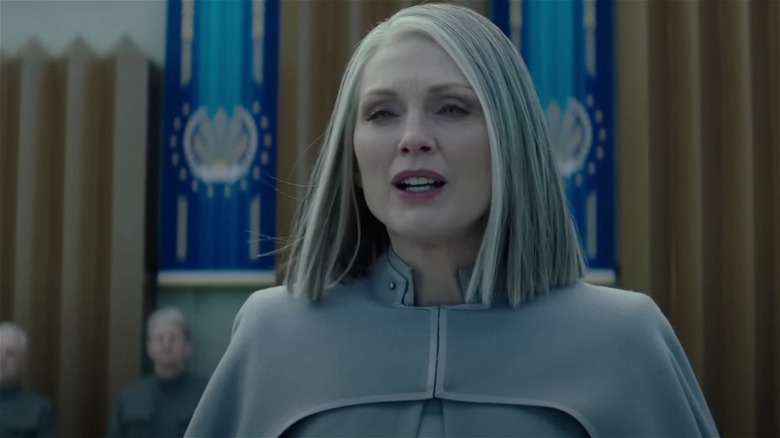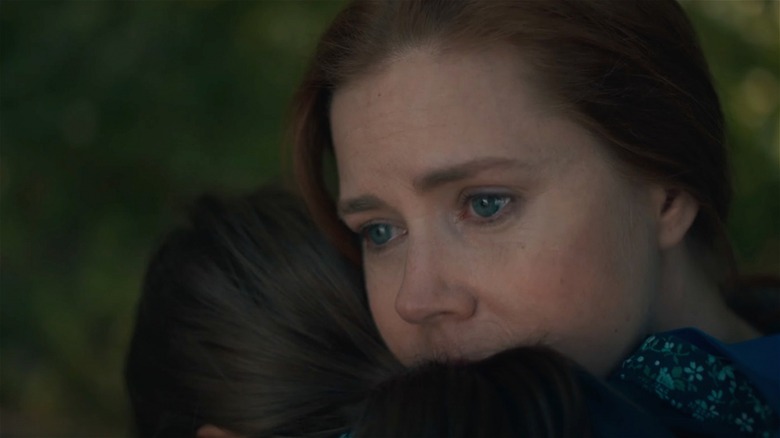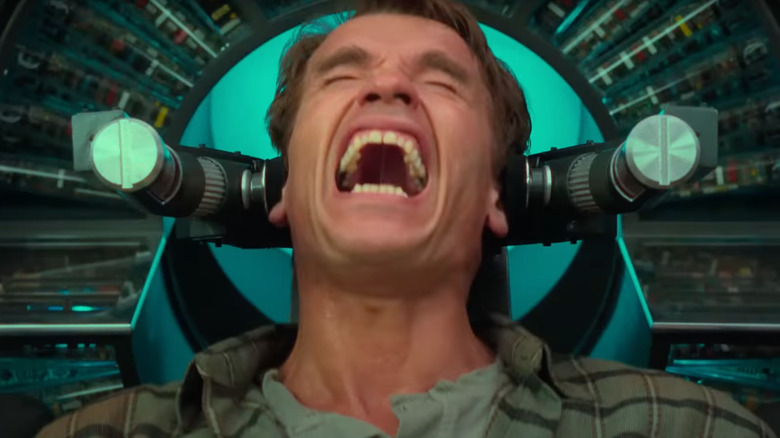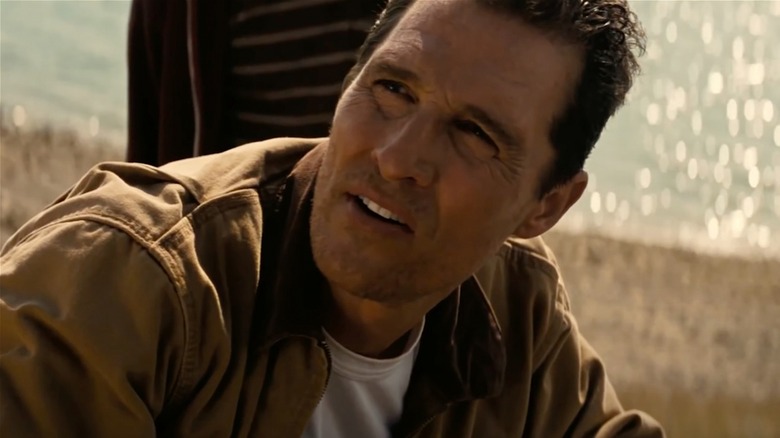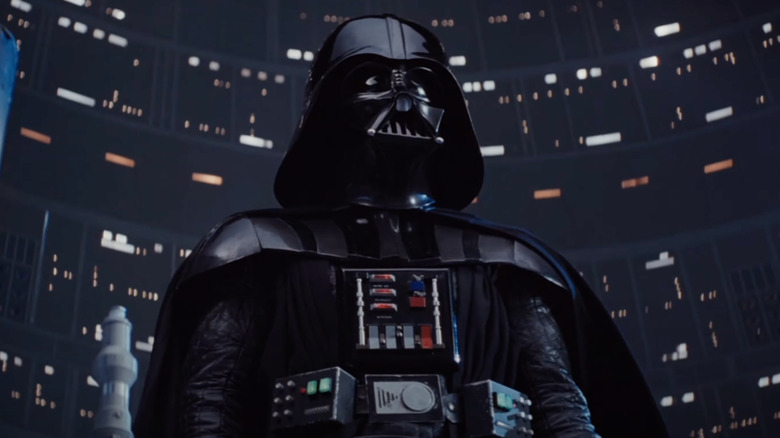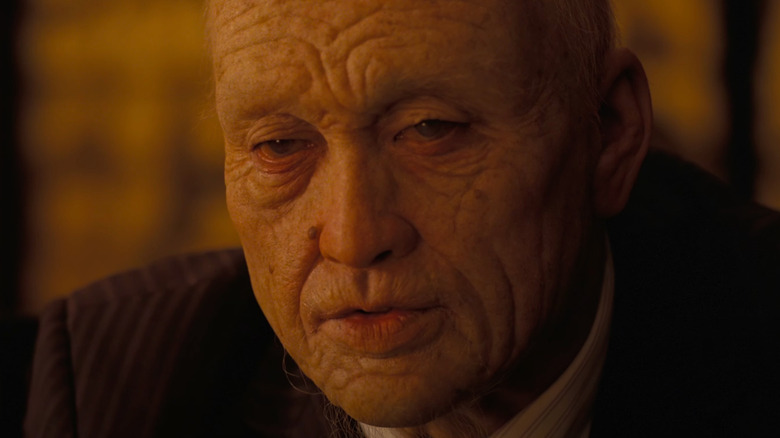Sneaky Clues Everyone Missed In Sci-Fi Movies
Every year, dozens of science-fiction films hit theaters but only a few feature enough intelligence and power to leave a mark. The best ones challenge our minds with captivating ideas and cause us to rethink the world and our place in it. Think Steven Spielberg's "Close Encounters of the Third Kind," Stanley Kubrick's "2001: A Space Odyssey," or John Carpenter's "The Thing," all drastically different tales with unique perspectives on the universe. Or, for a little more fun, hit up Spielberg's "E.T.," George Lucas' "Star Wars," or Luc Besson's "The Fifth Element," then explore the darker nature of life with Ridley Scott's "Blade Runner" and Andrew Niccol's "Gattaca."
The point is that science fiction caters to all crowds—even those needing a good twist. Luckily, the genre features several pictures designed to make heads explode with stunning third-hour revelations. Often, these plot twists come on the heels of meticulously crafted foreshadowing, prompting viewers to reembark on the journey to catch all the minute details they missed during the first viewing. Now, if you're a poor sap who has seen "Jurassic Park" a million times without noting Spielberg's knack for foreshadowing, we've got you covered. Read on to learn about sneaky clues everyone missed in sci-fi movies.
Be warned, lots of spoilers ahead!
The World's End
For those who haven't yet experienced Edgar Wright's brilliant "Three Flavours Cornetto" trilogy, I strongly recommend that you stop reading now, fire up your TV, and scour the various streaming services to locate "Shaun of the Dead," "Hot Fuzz," and "The World's End." I promise you'll have an absolute blast.
If you're like me, you've watched these films so often that you can recite entire scenes without a hitch. However, that doesn't mean you've caught every crucial detail. Edgar Wright is an exceptionally imaginative director, and he infuses his movies with a plethora of visual gags, some only discernible upon a second or third viewing. Uniquely, in "The World's End," the trilogy's final installment, the names of the various pubs that Gary (Simon Pegg) and his friends visit hold significant meanings related to the film's plot. For instance, "First Post" marks the beginning of the legendary Golden Mile, while "Old Familiar" signifies the reunion of old friends, including Sam (Rosamund Pike). "The Cross Hands" is where Sam and company first confront the androids, aptly named "Blanks," who use their hands as weapons. There's even a local spot called "The Hole in the Wall," which our heroes drive a car through during a crucial rescue operation.
These pub names serve as clever foreshadowing and chapter titles for this eccentric sci-fi comedy.
Alien
In Ridley Scott's 1979 horror classic "Alien," the crew of a commercial space tug called the "Nostromo" inadvertently brings a deadly organism on board their ship, leading to a series of fatal encounters until only Ellen Ripley (Sigourney Weaver) survives. Adding to the complexity is a robot named Ash (Ian Holm), whose true nature remains concealed until later in the film.
This twist was a startling revelation for many viewers, as Ash convincingly mimics human behavior without revealing his mechanical identity — or does he? Upon repeated viewings, it becomes clear that Scott drops subtle hints throughout the story. In the opening scene, the crew emerges from an extended cryosleep. While everyone is naturally groggy, Ash exhibits a peculiar, erratic jogging-in-place movement. It might seem insignificant initially, but Scott and Holm included this detail to allude to Ash's secret.
"The first sign here that Ian isn't necessarily what you think he is," Scott explained in the DVD commentary. "Is he arthritic, or is it something else? Or have the years in space affected his joints? That was a little suggestion by [Holm], which I thought was great... an actor truly delving into the complexities of science fact, not just science fiction." Watch the scene again, and you'll find it remarkably unsettling.
Jurassic Park (1993)
Steven Spielberg's iconic dinosaur adventure "Jurassic Park" continues to hold its place among the greatest blockbusters ever made. Despite a slew of sequels, the original stands out as the best of the bunch, thanks to Spielberg's impeccable direction and the intelligent approach to Michael Crichton's source material.
Since "Jurassic Park" is widely known, there's no need to delve into plot details. Suffice it to say that our main characters make a startling discovery: dinosaurs on the island found a way to reproduce, even without male species. The females have spontaneously changed their sex, allowing them to produce offspring. As Dr. Alan Grant (Sam Neil) aptly notes, "Life found a way."
This revelation occurs toward the end of the film and underscores nature's unpredictability. However, Spielberg cleverly hints at this twist through a subtle joke during our heroes' helicopter journey to the island. As the helicopter begins its final descent, unexpected turbulence prompts everyone to fasten their seat belts. Unfortunately, Grant's seat belt consists of two female ends, symbolizing the female dinosaurs. Through some improvisation, Grant manages to connect the two ends, securing his seat belt while playfully foreshadowing the twist that life indeed finds a way.
Minority Report
In Steven Spielberg's classic murder mystery "Minority Report," the story unfolds in a not-so-distant future where a group of beings known as Precogs identify and, with the help of law enforcement, prevent murders before they happen. Into this scenario comes John Anderton (Tom Cruise), a commanding officer in the Precrime program who becomes a fugitive when a Precog vision places him at the scene of a future murder. Filled with clever plot twists and a not-so-subtle commentary on the media's intrusion into our privacy, "Minority Report" is a crime thriller that combines dark humor with an eye-catching visual spectacle.
Spielberg, ever the crafty director, carefully sets the stage for the various surprises that emerge later in the film, ensuring they don't appear out of nowhere. Early on, Anderton discusses Precrime with Danny Witwer (Colin Farrell), an agent from the Department of Justice. Anderton staunchly believes the system is flawless, while Witwer disagrees. He points out that the Precogs cannot predict suicides since taking one's own life doesn't technically constitute murder. This aspect plays out when Anderton confronts Leo Crowe, who uses Anderton's gun to end his life. Later, Lamar Burgess (Max von Sydow), the true antagonist of the story, also resorts to suicide out of desperation. In both cases, the Precogs saw potential futures but couldn't provide a precise interpretation due to their inability to predict suicides.
Transformers: Dark of the Moon
Who would've thought Michael Bay, often criticized for his big-budget action films like "Armageddon," "Bad Boys," and "The Rock," could be sly? The action maestro built up and destroyed the "Transformers" universe over two decades. While most of these pictures leave plenty of meat on the bone, creatively speaking, Bay sneaks in a few clever references that fans appreciate.
For the third installment, Bay and screenwriter Ehren Kruger spun a tale of deception centered around the space race between the United States and Russia, allegedly leading to the discovery of a robot named Sentinel Prime.
Here's where it gets interesting. The late Leonard Nimoy of "Star Trek" fame — who was married to Bay's cousin, Susan Bay — voices Sentinel Prime, and "Dark of the Moon" makes a few nods to his iconic Spock character, including the famous line, "The needs of the many outweigh the needs of the few." However, the best homage also happens to be a spoiler for the film's conclusion.
In one scene, an Autobot named Wheelie watches an episode of "Star Trek" and remarks, "Ah, s***, I've seen this one. This is the one where Spock goes nuts." He's referring to the "Amok Time" episode, in which Spock loses control and ends up battling Captain Kirk in an arena. In "Dark of the Moon," Sentinel Prime turns against his fellow Autobots due to a secret alliance with Megatron. So, Wheelie's comment was a playful hint at the film's third-act twist.
Planet of the Apes
"Planet of the Apes" remains a landmark in science fiction cinema and a captivating movie experience, despite the now-dated effects and costumes. For those yet to embark on this thrilling adventure, Charlton Heston portrays an astronaut named George Taylor, whose spacecraft crash lands unexpectedly on a planet inhabited by, well, apes. In this peculiar world, humans are the primitive species, while the apes hold dominion. George, aided by a few benevolent apes, ventures into an area known as the Forbidden Zone and uncovers a shocking truth: the planet of the apes is, in fact, a post-nuclear war Earth, as indicated by the Statue of Liberty lying beside the ocean.
In 1968, this twist was the equivalent of the "Bruce Willis is actually dead" revelation from "The Sixth Sense," leaving moviegoers astounded. Yet, had they paid closer attention, they would have noticed numerous clues pointing to it. In one conspicuous example, Taylor examines a map devoid of names that unmistakably resembles New York City. The area he indicates in the Forbidden Zone is precisely where the Statue of Liberty stands. One can almost envision a cartographer rolling their eyes over missing out on one of Hollywood's most incredible twists by such an obvious detail.
The Hunger Games - Mockingjay
Young adult adaptations aren't my jam, but "The Hunger Games" franchise is an exception. The movies, based on Suzanne Collins' novels, completely engrossed me. Jennifer Lawrence portrays Katniss Everdeen, a young woman thrust into brutal games for the amusement of the elite. As the series unfolds, she becomes entangled in political intrigue, torn between rebels and the sinister President Snow (Donald Sutherland), determined to maintain his grip on power.
In "Mockingjay – Part 1," the heroes employ Katniss as a propaganda tool. President Alma Coin (Julianne Moore) spearheads this effort, but her questionable ethics cast doubt on Katniss's commitment to their cause. In the climax, Coin's ruthless act of killing children is pinned on Snow, seemingly ending the conflict. Realizing Coin's authoritarian nature, Katniss takes matters into her own hands and eliminates her to restore order.
It's a lot to digest, but in retrospect, we should have recognized Coin's evil core much earlier. Pay attention to Coin's wardrobe the next time you watch the series. As the films progress, her attire evolves from simple clothing to elegant suits more in line with Snow and other Capitol members. Her hair becomes more stylized and white, mirroring Snow's appearance until she looks just like the man in her final scene. Here's a word of advice: if the leader you're following into battle starts dressing like the enemy, removing them from power is the way to go.
Arrival
Before he played with giant worms in "Dune," director Denis Villeneuve dipped his toes in sci-fi with "Arrival," an intelligent drama centered around an alien invasion. Well, kinda. The aliens in the film, nicknamed Abbott and Costello, have no intention of invading Earth. Instead, they desire to give humanity an incredible gift: the ability to see time non-linearly. Dr. Louise Banks (Amy Adams) discovers that her dreams about her daughter are from the distant future, allowing her to make decisions based on events that haven't happened yet. I still don't understand it.
Of course, the time travel angle is the film's biggest twist, revealed during the climactic third act. Nevertheless, Villeneuve goes hard on the foreshadowing here, prepping audiences for the big reveal through visual cues and pieces of dialogue. In an essay titled "Exploring Denis Villeneueve's 'Arrival,'" author Keaton Marcus notes how a scene in which Louise walks down a circular hallway "is juxtaposed with a previous shot of Louise walking in a straight line," foreshadowing her ability to "think in the future, utterly aligned with the alien's thoughts." More impressively, audiences have viewed Louise's life in much the same way. We see her final moments with her daughter early on and jump around various points in time throughout the story. "The language of the Heptapods represents the full circle that this movie has come before the end credits, key to understanding the film's underlying themes of meaning and interpretation."
Yeah, what he said.
Total Recall
Man, do I love "Total Recall." Paul Verhoeven's extraordinarily violent but morbidly funny sci-fi adventure sees Arnold Schwarzenegger slip into the role of Quaid, an average man who longs to do more with his life — like visit Mars, for example. Since the story takes place in 2084, technology is advanced enough to produce a company called Rekall that plants fake memories or implants in the minds of their customers, allowing them to enact their greatest fantasies. The gist is that we are never sure if the remaining film is just a dream inside Quaid's head or reality, even though plenty of clues point towards the latter.
During the famous procedure scene, an assistant named Ernie looks at the program chip containing Quaid's upcoming journey and offhandedly comments, "That's a new one — blue skies on Mars." I've seen "Total Recall" countless times and never picked up the throwaway line. What's so significant about this piece of dialogue, you ask? After Quaid successfully defeats his enemies and saves the day at the film's end, he and Melina (Rachel Ticotin) stand atop a ridge overlooking Mars' landscape. The camera pans up, and we see... a blue sky, suggesting Quaid's fantastic adventure was little more than a fantasy. That assistant was clearly onto something.
Interstellar
Christopher Nolan, the king of foreshadowing, hides clues that pay off at the end of the film. He has quite a bit of fun with "Interstellar," his time-bending space drama about man's mission to locate a new planet for humans to inhabit. The film explores the concept of time and reveals that Matthew McConaughey's character, Cooper, figures out a way to communicate with his daughter Murph (Jessica Chastain) in the past. Nolan teases this twist via a series of supernatural occurrences in the past caused by future Cooper. Of course, no one knows that Cooper is causing these events. Murph even thinks a ghost haunts their house. Well, plot twist: the ghost was Cooper all along.
Pretty neat, right? Nolan doesn't stop there. A second rewatch offers a fun tease at the twist. Young Murph (Mackenzie Foy) first appears on screen when she awakens Cooper. "I thought you were my ghost," she says. If only the kid knew how right she was, and if only we'd paid more attention on our first showing — we would have seen the big reveal coming from a mile away.
The Empire Strikes Back
In terms of sequels, you can't do much better than "The Empire Strikes Back." George Lucas' original "Star Wars" might have been a case of capturing lightning in a bottle. Still, the 1980 follow-up somehow deepened and built upon the established lore, leading to one of the most shocking twists in cinema history.
We all know the tale. During the climactic lightsaber clash between Darth Vader (David Prowse) and Luke Skywalker (Mark Hamill), the Sith Lord reveals that he is, in fact, Anakin Skywalker — Luke's father — a stunning reveal that floored audiences who believed Obi-Wan Kenobi (Alec Guinness) when he claimed Vader betrayed and murdered Anakin years ago. Vader's words may not have surprised attentive moviegoers, as Lucas, writer Lawrence Kasdan, and director Irvin Kirshner sprinkled clues about the dark lord's true identity throughout the picture.
On Dagobah, for example, Luke engages in an imaginary duel with Vader in a mysterious cave that ends with him decapitating the Sith Lord. The disconnected head tumbles onto the ground and explodes, revealing Luke's face inside. Now, one might interpret this as a warning to Luke that he might turn to the Dark Side if he's not careful, or we could see this as a very obvious clue that a Skywalker resides underneath Vader's mask, thus spoiling the "I am your father" bit before it comes to fruition.
Inception
"Inception" features enough foreshadowing to fill an entire article. During an extended prologue, Dom Cobb (Leonardo DiCaprio) notes that he doesn't like trains, setting up his eventual death with Mal in the dream world. Throughout the story, our heroes use "totems," devices that allow them to determine if they are in the real world or stuck in a dream. Dom uses a spinning top for his totem, but if you pay close attention, you'll notice that he only wears his wedding ring when he's in a dream, which is helpful for those trying to determine his fate in the final scene.
Still, the most subtle foreshadowing happens when our dream team mounts an attack in the snow level or the dream within a dream within a dream. During this stretch, Saito (Ken Watanabe) and Fischer (Cillian Murphy) evade an avalanche, forcing the latter to scream out, "Couldn't someone have dreamt of a g****** beach?" Later, we see that Saito heeded Fischer's advice and built a fortress atop a beach, where he encounters Cobb at the film's beginning (and end). Some may call this a coincidence, but I've seen enough of Christopher Nolan's work to know that the man does nothing by accident. Saito's subconscious stored Fischer's outburst and designed a more habitable environment for him to await his rescue.
